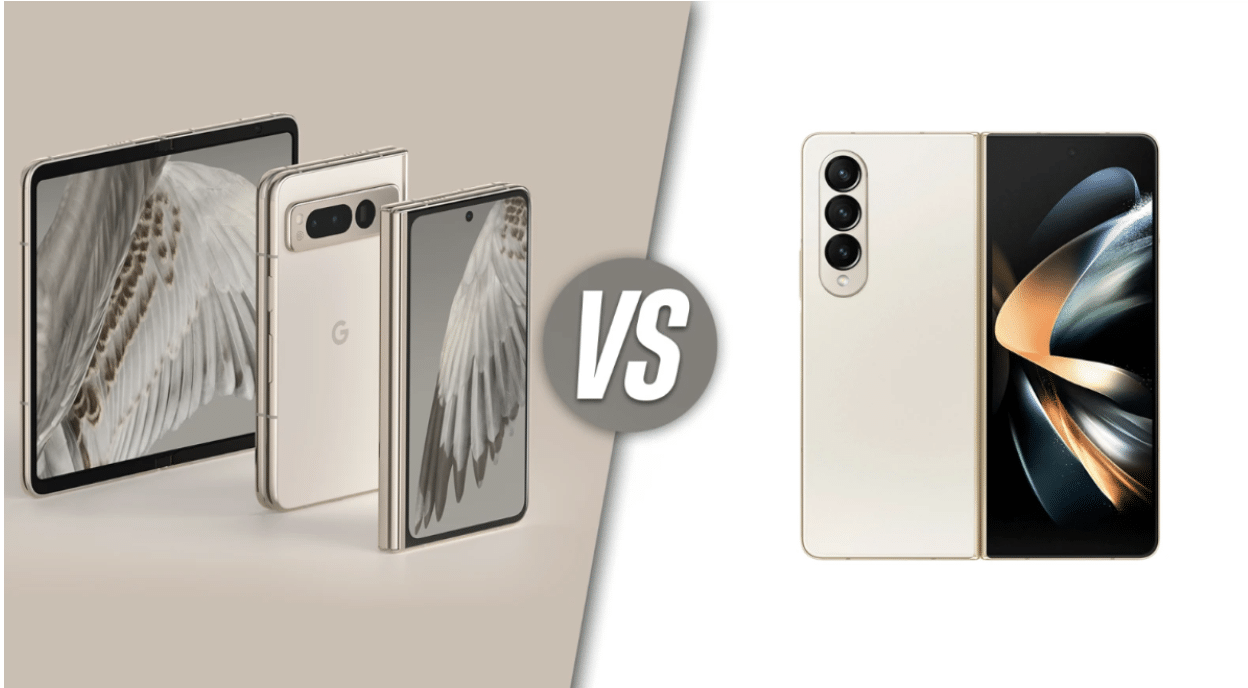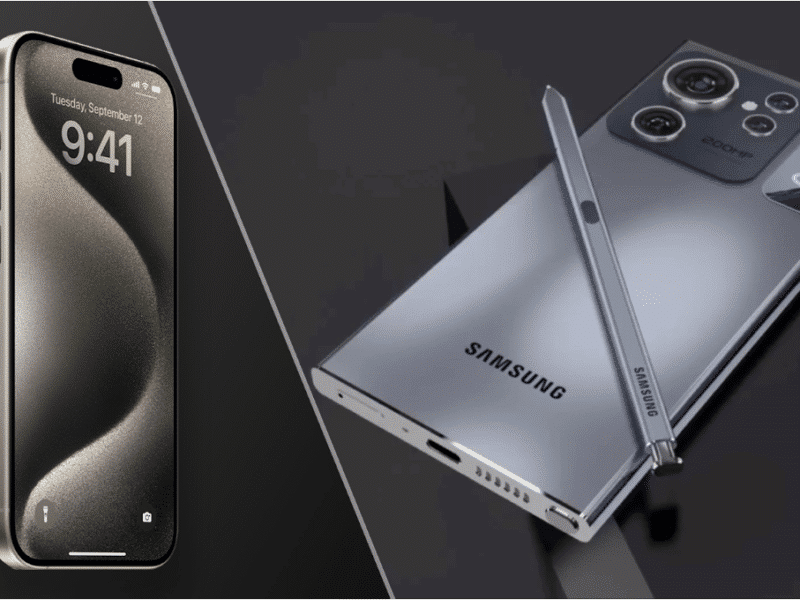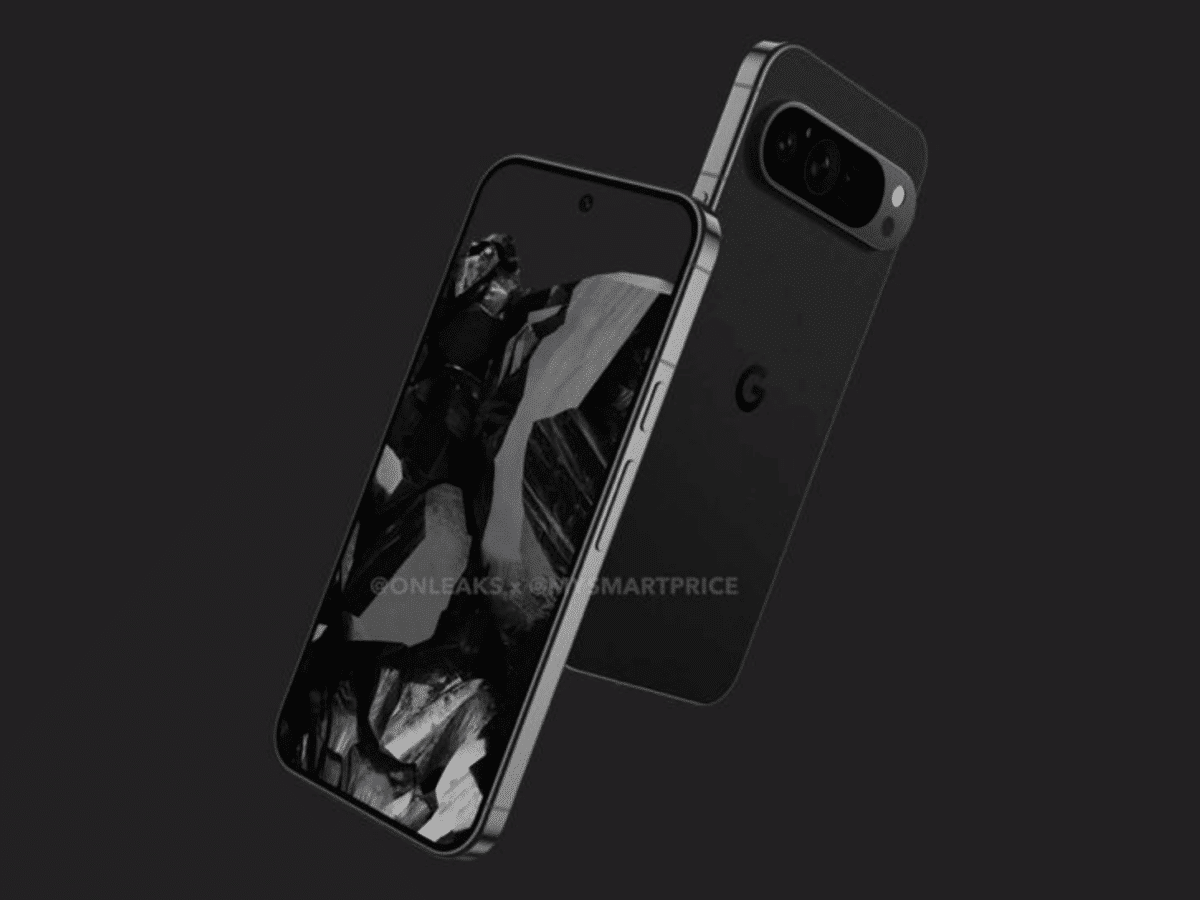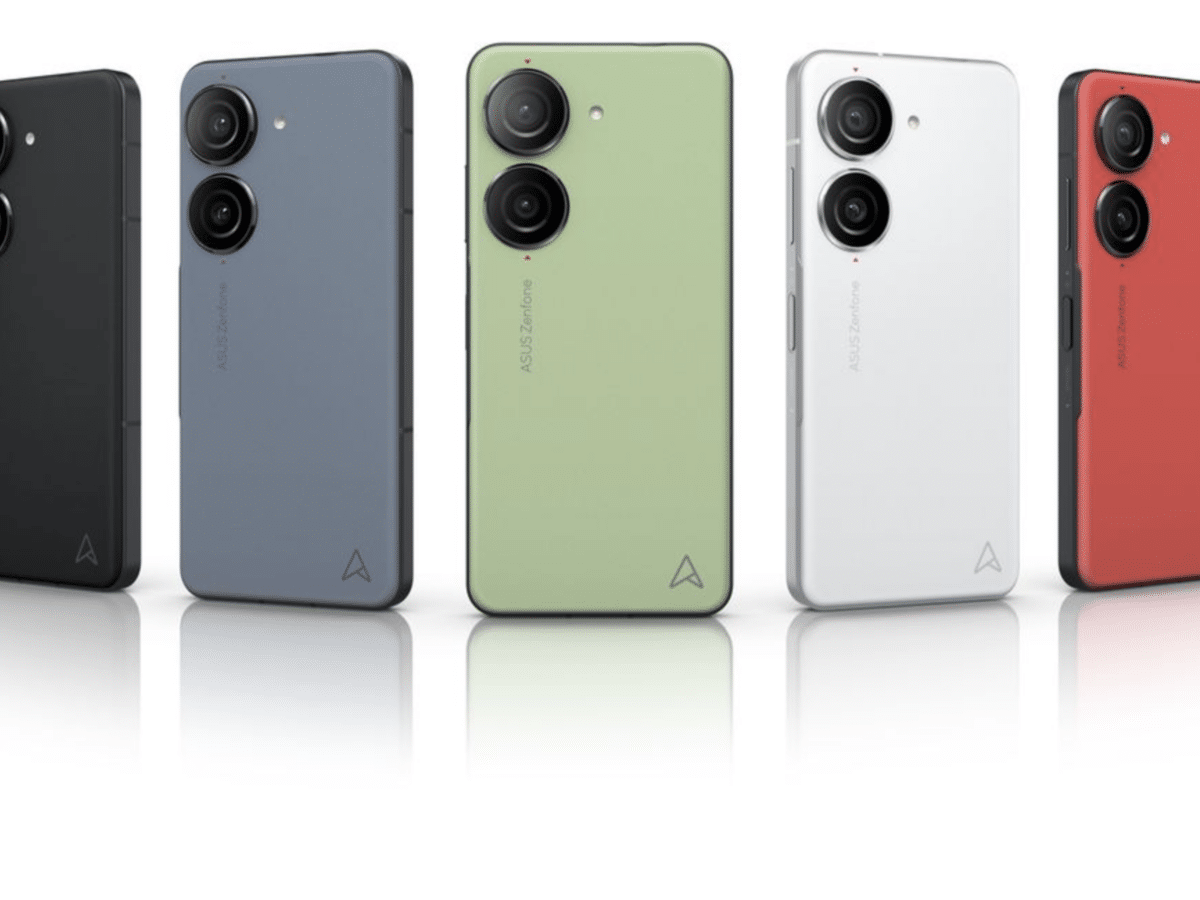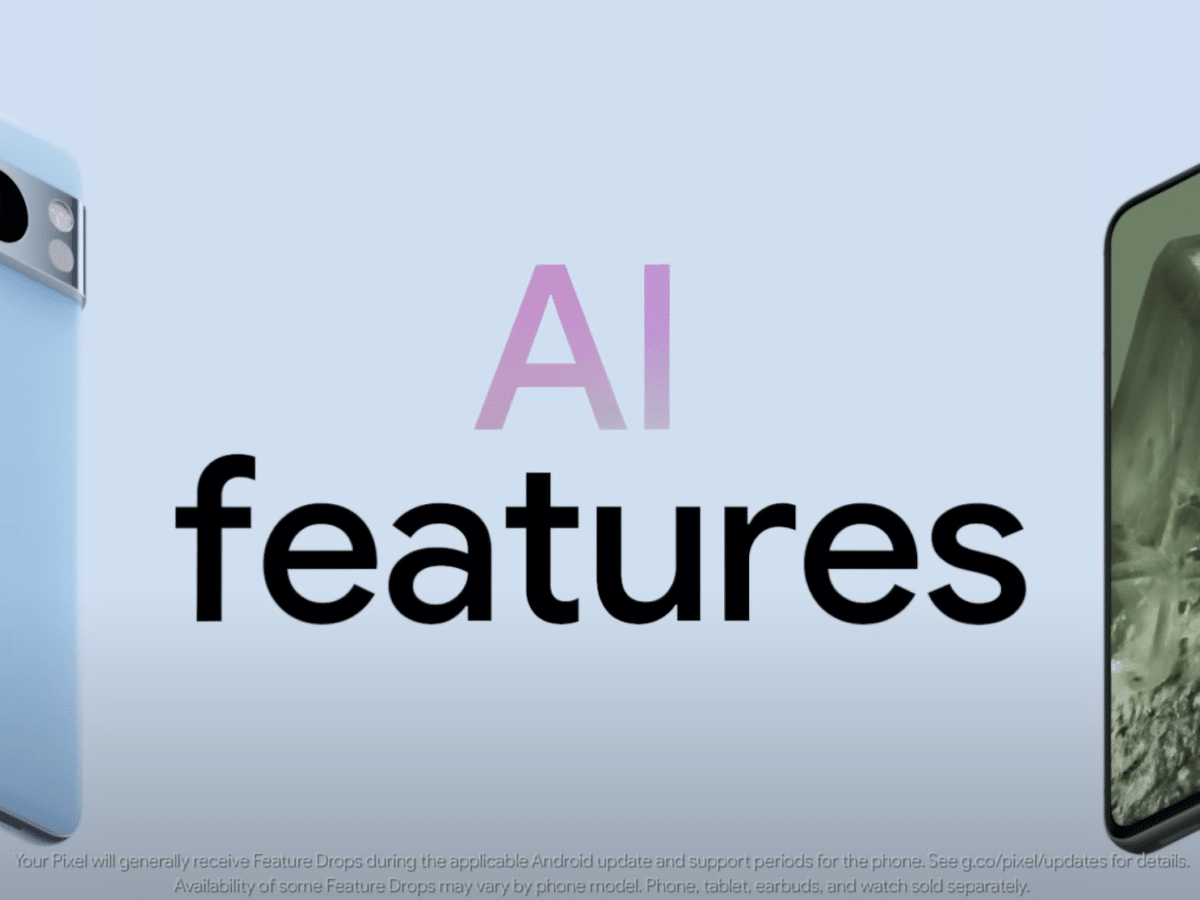From the classic Motorola StarTAC, the first recognized foldable, to more sophisticated models like the Samsung Z Fold series, foldable tech has significantly progressed.

Nowadays, when we discuss foldables, we’re mainly talking about smartphones with bendable, foldable screens. What constitutes a foldable might differ, but typically, they have a hinge for folding, and their screens are made from flexible material.
As the popularity of foldables surges, several mobile phone makers have launched their versions. In this piece, we’ll pit Google’s Pixel Fold against Samsung’s Galaxy Z Fold 4. Let’s dive in and see which foldable takes the crown.
Design and Dimensions
| Google Pixel Fold | Samsung Galaxy Z Fold 4 | |
| Design | Book-style design | Improved design from Z Fold 3 |
| Dimensions (Folded) | 139.7 x 79.5 x 12.1mm | 155.1 x 67.1 x 15.8mm |
| Dimensions (Unfolded) | 139.7 x 158.7 x 5.8mm | 155.1 x 130.1 x 6.3mm |
| Dust Resistance | Yes | No |
| Water Resistance | IPX8 | IPX8 |
| Fingerprint Sensor Location | Power button | Power and sleep button |
| Weight | 283g (10 ounces) | 263g (9.28 ounces) |
Google’s Pixel Fold, with its book-like design, is hailed as the thinnest foldable phone. It boasts a thickness of 6.4mm when closed and a mere 4.2mm when opened. In terms of dimensions, it goes from a convenient 139.7 x 79.5 x 12.1mm when folded to a more expansive 139.7 x 158.7 x 5.8mm when unfolded. Its unique hinge design provides improved dust resistance and an IPX8 water resistance rating.
Echoing the Pixel 7 Pro, the Pixel Fold features a sleek unibody design with a power button that doubles as a fingerprint sensor and high-quality stereo speakers. Its standout feature is the Tabletop Mode, ensuring an ideal viewing angle. The device’s internal screen is protected by Gorilla Glass Victus, covered by a protective plastic layer.
On the other hand, Samsung’s Z Fold 4 presents significant design improvements. When closed, it measures 155.1 x 67.1 x 15.8mm, extending to 155.1 x 130.1 x 6.3mm when open. It has a slimmer, shorter design when folded compared to its predecessor, the Z Fold 3.
The Z Fold 4 is equipped with a SIM slot, speaker and mic holes, a speaker grille, a main microphone, a USB Type-C port, and a power/sleep button with an embedded fingerprint sensor. Its redesigned hinge blends seamlessly with the frame when folded. While it also boasts an IPX8 water resistance rating, it lacks dust resistance.
Considering weight, the Pixel Fold is slightly heavier for a foldable, tipping the scale at 283g (10 ounces), while the Galaxy Z Fold 4 is lighter at 263g (9.28 ounces).
Display
| Google Pixel Fold | Samsung Galaxy Z Fold 4 | |
| Inner Display Size | 7.6-inch | 7.6-inch |
| Outer Display Size | 5.8-inch | 6.2-inch |
| Inner Display Resolution | 2208 x 1840 pixels | 2176 x 1812 pixels |
| Outer Display Resolution | 1080 x 2340 pixels | 2316 x 904 pixels |
| Refresh Rate | 120Hz | 120Hz |
| Peak Brightness (Inner Display) | 1,450 nits | 1,000 nits |
| Peak Brightness (Outer Display) | 1,550 nits | 1,000 nits |
| HDR Brightness (Inner Display) | 1,000 nits | 1,000 nits |
| HDR Brightness (Outer Display) | 1,200 nits | 1,000 nits |
| Display Aspect Ratio (Inner) | 6:5 | 21.6:18 |
| Display Type | OLED | AMOLED |
| Bezels | Thicker | Slimmer |
The Pixel Fold sports a 7.6-inch OLED screen when open, reducing to a 5.8-inch OLED display when closed. It offers a 120Hz refresh rate and an always-on display feature, peaking at a brightness of 1,550 nits. On the other hand, the Galaxy Z Fold 4 showcases a 7.6-inch primary display and a 6.2-inch cover display, both supporting an adaptive 120Hz refresh rate and a consistent brightness of 1,000 nits.
Interestingly, the Pixel Fold’s front display is shorter but wider than the Z Fold 4’s, leading to different aspect ratios, which could impact user preference. Also, the Pixel Fold features thicker screen bezels than the Z Fold 4’s. While this design may prevent accidental touches, some users may find it less aesthetically pleasing. Therefore, this aspect could be both a plus and a minus, depending on personal taste.
Performance and Hardware
| Google Pixel Fold | Samsung Galaxy Z Fold 4 | |
| Chipset | Google Tensor G2 | Snapdragon 8 Plus Gen 1 |
| CPU Configuration | 2x Cortex-X1 (2.85 GHz), 2x Cortex-A78 (2.35 GHz), 4x Cortex-A55 (1.8 GHz) | 1x Cortex-X2, 3x Cortex-A710, 4x Cortex-A510 |
| GPU | Arm Mali-G710 MP7 | Adreno 670 |
| RAM | 12GB | 12GB |
| Storage Options | 256GB, 512GB | 256GB, 512GB, 1TB |
| AnTuTu 9 Benchmark Score | 789,237 | 1,054,587 |
Google’s Pixel Fold runs on its exclusive Tensor G2 chipset, which features an 8-core setup with two Cortex-X1 cores, two Cortex-A78 cores, and four Cortex-A55 cores. Graphics are powered by an Arm Mali-G710 MP7. It’s equipped with a substantial 12GB RAM and storage options of 256GB or 512GB.
Samsung’s Galaxy Z Fold 4 uses the Qualcomm Snapdragon 8 Plus Gen 1 chipset, consisting of a Cortex-X2 CPU core, three Cortex-A710 cores, and four Cortex-A510 cores. Graphics are handled by an Adreno 670 chip. It also carries 12GB of RAM and offers storage starting at 256GB, upgradable to 512GB or a whopping 1TB.
Both phones have impressive octa-core processors. However, benchmark tests indicate that the Galaxy Z Fold 4’s Snapdragon 8 Plus Gen 1 slightly outperforms the Pixel Fold’s Tensor G2. AnTuTu 9 benchmark results show the Snapdragon 8 Plus Gen 1 surpassing the Tensor G2 in CPU, GPU, Memory, and UX performance. So, while both devices are powerhouses, the Galaxy Z Fold 4 edges ahead in raw processing power.
Camera
| Google Pixel Fold | Samsung Galaxy Z Fold 4 | |
| Primary Rear Camera | 48MP | 50MP |
| Ultra-Wide Rear Camera | 10.8MP | 12MP |
| Telephoto Rear Camera | 10.8MP (5x optical zoom, 20x digital zoom) | 10MP (3x optical zoom, 30x Space Zoom) |
| Cover Screen Selfie Camera | 9.5MP | 10MP |
| Foldable Screen Selfie Camera | 8MP | 4MP |
| 4K Video Recording | Yes | Yes (also supports 8K 24fps) |
| Unique Camera Features | Magic Eraser, Photo Unblur, Rear Camera Selfie, Tabletop mode, Tent mode | Nightography, Flex mode, Rear Cam selfie mode, Pro mode |
The Google Pixel Fold features a three-lens rear camera setup, similar to the Pixel 7 Pro, with a 48MP primary, 10.8MP ultra-wide, and 10.8MP telephoto lens. Its telephoto lens offers 5x optical and 20x digital zoom. There are two front-facing cameras for selfies and video calls, and a unique Rear Camera Selfie feature. New camera modes have been introduced to suit its foldable design.
The Galaxy Z Fold 4 follows the Galaxy S22 series’ camera configuration with a 50MP main sensor, 12MP ultra-wide, and 10MP telephoto lens. It impresses with a 3x optical zoom and 30x Space Zoom. It also includes two selfie cameras, 8K 60fps recording capabilities, Nightography for improved low-light photography, and a Flex mode for hands-free shooting.
Comparing the two, both have similar three-lens rear setups and dual front-facing cameras. However, the Pixel Fold has a slight edge with Google’s advanced image processing for clearer, more vibrant images.
Operating System and Software
| Feature | Pixel Fold | Galaxy Z Fold 4 |
| Operating System | Android 13 | Android 12 |
| Unique Software Features | Disappearing taskbar, split-screen and tabletop modes for video apps | Improved multitasking with Taskbar and customizable favorites |
| Simultaneous App Use | Yes | Yes |
| Drag and Drop Between Apps | Yes | Yes |
| Software-Hardware Integration | Potential advantages due to Google’s ownership of Android | More years of experience in optimizing software for foldables |
The Pixel Fold, operating on Android 13, offers new features like a disappearing taskbar and split-screen and tabletop modes, improving multitasking and user experience. The Galaxy Z Fold 4, powered by Android 12, also presents enhanced multitasking, a customizable favorites section, and easy drag-and-drop file sharing between apps.
While both devices showcase unique software improvements, Google’s Android ownership may give the Pixel Fold an advantage for more seamless software-hardware integration in the future. Samsung’s Galaxy Z Fold 4, however, benefits from the company’s extensive foldable market experience, assuring optimized software application.
Network Connectivity
| Feature | Google Pixel Fold | Samsung Galaxy Z Fold 4 |
| 2G | Yes | Yes |
| 3G | Yes | Yes |
| 4G | Yes | Yes |
| 5G | Yes | Yes |
| Ultra-Wideband | Yes | No |
| Bluetooth 5.2 | Yes | Yes |
| Wi-Fi 6/6E | Yes | Yes |
Google’s Pixel Fold and Samsung’s Galaxy Z Fold 4 both provide a broad range of network options, including 2G, 3G, 4G, and the speedy 5G. They also support Bluetooth 5.2 and Wi-Fi 6/6E, ensuring strong and flexible connectivity. Both devices are future-ready with 5G, promising quicker data transfer rates than 4G. However, the Pixel Fold takes a slight lead by including Ultra-Wideband technology, a feature absent in the Galaxy Z Fold 4.
Battery and Charging
| Device | Battery Capacity | Wired Charging Speed | Wireless Charging Speed | Battery Longevity | Unique Features |
| Pixel Fold | 4,727mAh | 21W | 7.5W | Over a day (up to 3 days with Extreme Battery Saver) | – |
| Galaxy Z Fold 4 | 4,400mAh | 25W | 10W | Not specified | Supports reverse wireless charging |
Google’s Pixel Fold boasts a slightly larger battery of 4,727mAh compared to the Galaxy Z Fold 4’s 4,400mAh. Both support wired and wireless charging. The Pixel Fold, however, holds a charge longer than the Galaxy Z Fold 4, with Google promising up to three days’ life with Extreme Battery Saver.
But note that its charging speeds, 21W wired and 7.5W wireless, are slower. The Galaxy Z Fold 4 charges faster at 25W wired and 10W wireless and uniquely offers reverse wireless charging. So, if battery longevity matters most, go for the Pixel Fold; but for faster charging, consider the Galaxy Z Fold 4.
Price and Availability
| Device | Base Price | 256GB Price | 512GB Price | 1TB Price | Pre-order Date | Shipping Date |
| Pixel Fold | $1,799 | $1,799 | $1,919 | – | May 10, 2023 | June 2023 |
| Galaxy Z Fold 4 | $1,799 | $1,799 | $1,919.99 | $2,159.99 | – | August 26, 2022 |
The Pixel Fold and the Galaxy Z Fold 4, both high-end devices, share a base price of $1,799 for their 256GB models. The Pixel Fold’s 512GB version costs $1,919, with pre-orders starting from May 10, 2023, and shipping expected in June.
Samsung’s Galaxy Z Fold 4, already available since August 26, 2022, offers 512GB and 1TB models priced at $1,919.99 and $2,159.99, respectively. These premium smartphones are similarly priced, but the Galaxy Z Fold 4 has an additional 1TB model, a storage option not available with the Pixel Fold.
Pixel Fold vs. Galaxy Z Fold 4; What’s the Difference?
The Google Pixel Fold and the Samsung Galaxy Z Fold 4 are two of the hottest foldable devices in the smartphone market right now. We have shed light on their specifications and capabilities to highlight just how powerful these flagship devices are. If you choose to purchase either of the devices, keep in mind what works best for you. Both foldables function better in different departments, and it is important to choose carefully according to your preference, needs, and budget.

